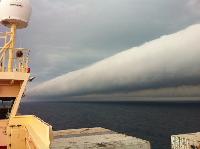Amazing Science Images You Must See
Amazing Science Images You Must See
91. Silver Steam
Water and land seem swapped in this satellite photo taken over the South Pacific. The steaming volcanic island of Tinakula appears in dark, almost liquid, green. The surrounding water takes on a milky, solid look because of the reflection of sunlight on the ocean.
Satellite observations of Tinakula suggest that the island erupts occasionally, but remote as it is, eyewitnesses are rare, according to NASAs Earth Observatory. Here, a plume of gas and perhaps ash rises lazily above the island.
92. Vanishing Water
Like something out of a fantasy land, the Icelandic waterfall Gullfoss pours nearly 5,000 cubic feet (140 cubic meters) of water over its edge each second. Gullfoss (which means Golden Falls in English) is on the Hvita river in southwest Iceland. The falls were once considered for hydroelectric power, but fortunately for this stunning vista, they were sold to the Icelandic government instead and preserved. Now the spot is one of the most popular tourist destinations in Iceland.
93. Horizontal Tornado
A roll cloud, associated with thunderstorm downdrafts and strange sea winds, tumbles across the sky off the coast of Brazil. Roll clouds are rare and harmless, though ominous looking.
94. Eerie Earthshine
Everyones heard of sunshine and moonshine (and not the stuff that comes in glass jars). But the Earth shines too. Sunlight bounces off our planet, hits the moon and bounces back, visible as the silvery light seen here reflecting off Earths natural satellite above the European Southern Obervatorys (ESO) Paranal Observatory in Chile.
New research published Feb. 29 in the journal Nature suggests that this Earthshine may be useful for more than beauty, however. Researchers led by Michael Sterzik of the ESO found that you can measure the polarization of Earthshine to reveal our planets cloud cover, ocean surface and even vegetation cover. Using Earth as a test case, researchers could develop methods to study light signals bouncing off far off exoplanets to determine their landscapes, the researchers reported.
95. Our Tangled Magnetic Shield
Spaghetti dinner gone sour? Some sort of fancy new knitting technique?
No, this is a computer simulation of the complex and crazy magnetic fields that make up Earths magnetosphere. The magnetosphere is the result of the interaction of charged particles from the sun and the magnetic field that surrounds the planet. When solar storms send particles flowing toward Earth, the result can be stunning space weather the kind that creates beautiful auroras but also can disrupt satellites, telecommunications and electrical power grids. Researchers at Oak Ridge National Laboratory in Tennessee are trying to understand how these storms work in order to better predict how storms on the sun will influence life on our planet.
96. Lenticular Clouds
This spectacular, multi hued formation of so called lenticular clouds was observed over Rocky Mountain National Park, near Estes Park, Colo. Professional photographer Richard H. Hahn snapped the magnificent view soon after sunset at 5:02 p.m. MST (7:02 EST) on Jan. 5.
Lenticular clouds form when waves of moist, fast moving air are pushed upward by winds and ascend over high mountains. At the mountains higher altitude, the moist airs water droplets cool and expand, and the water vapor condenses. When the air moves over the mountain top and descends to uniformly humid air conditions, lenticular clouds form.
97. Oceans 8
A brilliant blue figure eight decorates the ocean as if someone painted it there. But this isnt mans work the phenomenon is caused by a phytoplankton bloom coloring the water in the South Atlantic about 379 miles (600 km) east of the Falkland Islands.
The Earth observing satellite Envisat captured this image of the algal bloom on Dec. 2, 2011. Satellites with ocean color sensors can even tell the species of the plankton from space, by analyzing the shade of the algaes chlorophyll pigment.
98. Oooh Aaah Aurora
The night sky puts on a colorful show like no other in this compressed wide angle view of the aurora over Norway in late 2011. The gyrating colors arecaused by charged particles hitting atoms in the high atmosphere.
99. Colorful and Cerebral
This tangled forest is a false color representation of the cells that make you who you are: neurons. Brain cells communicate in complex networks, but researchers are getting better and better and unraveling their signals.
Reporting Dec. 12 in the journal Neuron, Norwegian and German scientists say theyve used a supercomputer to better understand how the babble of thousands of nerve cells talking to one another translates when recorded onto an electrode of the sort used for electroencephalograms (EEGs). This translation effort should make it easier to design brain implants that help control epilepsy, or even enable a paralyzed patient to move his or her limbs with brain waves, the researchers said.
100. Funny Fellow
A blue dragonfly perches on a flower. The insect seems to be making googly eyes, but of course those black dots arent really pupils; dragonflies havecompound eyes with hundreds of tiny lenses.














